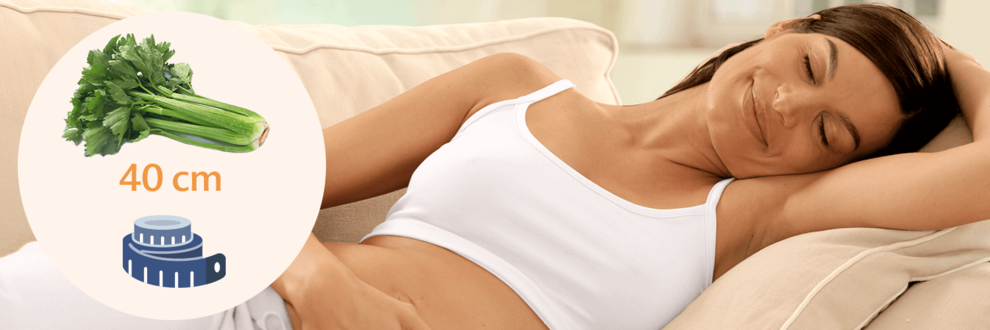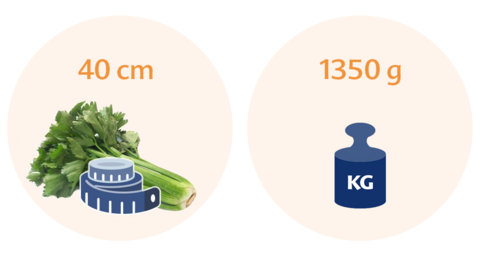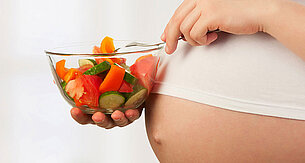Pregnancy weeks:
Week 30 of pregnancy: Your baby adopts the foetal position

In week 30, you’re midway through the eighth month of your pregnancy, and you’re in the third and final trimester. Your baby is now big enough to find things a bit cramped in your womb, so their movements will change.
Size of your baby in week 30

Your baby is now around 40 cm in size, about the same of a large celery – so they’re pretty big. They weigh between 1300 and 1400 grams, so nearly 1.5 kilograms or a bag and a half of flour. They’re approaching the size and weight that they’ll have when they’re born.
Your baby’s development
Lung development
Your baby’s lungs are more or less fully developed.
Digestive tract development
Your baby’s digestive tract is also largely complete – everything’s now in place that they’ll need later on to digest what they consume. They can drink, swallow, digest and egest the amniotic fluid, and these skills will be crucial when they’re outside the womb and dependent on your breast milk. However, as their intestine is not yet fully developed when they’re born, their digestive system as a whole can’t quite be considered fully mature. This means they’ll frequently suffer from wind and stomach aches, particularly until they’re three to four months old, though these are mostly harmless and no reason to worry.
Development of subcutaneous fat and capillaries
Your baby is starting to get a bit chubby as they put on their “baby fat”, which makes their body structure more compact. The small amounts of subcutaneous fat are the reserves they need after the birth in order to regulate their body temperature and survive until your breast milk (which contains more fats) is mature and ready for them to drink.
Subcutaneous fat is found just beneath the skin, but small blood vessels called capillaries have also formed there in order to supply their skin with the blood and nutrients they need through lots of tiny branches. As a result, your baby’s skin will now take on a pinkish colour.
Adopting the foetal position
The amount of amniotic fluid adjusts to the growth of your baby, reducing gradually in order to give them more space.
By this stage, there’s no longer enough space in your womb for them to stretch out, so they adopt what’s known as the foetal position by drawing their legs up towards their body. They’ll keep returning to this position even after they’re born, and it’s not until around three weeks after the birth that they’ll stretch out again in their cot. However, it’s not just the lack of space that encourages them to adopt this position: in their first few days outside the womb, it also helps them keep their body warm.
For this reason, it’s standard practice in many countries to put newborn babies in a swaddling bag rather than in a babygro so that they’re well wrapped up, as this replicates the cosiness of the womb and helps them keep their body at a warm temperature. This has a calming effect on them and helps them adjust to life outside the womb. If you can, try putting your baby in a sling, a pram, a swaddling bag, your arms and their cot at different times. Check that the swaddling bag is warm enough in winter, and make sure they get additional warmth if they need it.
Other developments
From week 30 onwards, the lanugo hair covering your baby will gradually disappear, leaving them with just a small amount of fuzz on their skin by the time they’re born. It has been scientifically proven (after many years of debate) that they can feel pain at this stage, and their tendency to use their left or right hand, which will later make them left or right-handed, is now also becoming clear.
What it’s like for the mum-to-be in week 30
Right now your main focus will be on minimising or avoiding the symptoms such as back and leg pain which affect so many pregnant women. You’ll find it harder to get around, and even climbing the stairs at home may leave you short of breath. This is partly because your lungs, like all the organs in your belly and chest, are being squeezed by your womb, but also simply because you’re carrying a much heavier load. Pregnancy is like high-level sport for a woman’s body, and it demands high-level performance.
Common signs and symptoms
Itchiness and stretch marks
You may sometimes notice itchiness as your skin becomes stretched. Dermatologists have demonstrated (and experience from other mums confirms) that rubbing cream or oil on a daily basis into the areas affected by your pregnancy is the best way to minimise this itchiness and reduce stretch marks, both in terms of size and appearance. Minor stretch marks will quickly disappear after the birth without leaving any unsightly scars.
However, applying cream to your skin won’t guarantee that you won’t get stretch marks, as it depends on the type of skin you have and your genes.
More hair on your belly
You will have definitely noticed that your body has changed in lots of ways over the last few weeks. Your areolas (the areas around your nipples) may have got darker and there may now be a pregnancy line, called the linea nigra, running from your belly button down to your pubic bone. Other possible symptoms are patches of hair on your belly, caused by hormones your body is now producing. It’s thought that women expecting a boy are more likely to get this hair, and to get more of it, as it may be the result of the male sex hormone testosterone, which causes hair growth. Another theory is that this hair grows because your belly needs additional protection. We don’t know for certain.
Questions you may want to ask your doctor
Confirming the position of the placenta and preparing for a possible caesarean section
At your next scan, the doctor will use the ultrasound image to determine the position of the placenta in your womb. If it’s partially or totally covering your cervix (placenta previa), this may be a cause for concern and you should be prepared to give birth via caesarean section.
Even though the technology involved in caesarean sections has come on in leaps and bounds in the last few decades, they should still be regarded as exceptions.
The 40-minute procedure involves delivering your baby by cutting into your womb, which means you will be under anaesthetic. The chosen anaesthetic will not harm your baby.
If you have placenta previa and are advised to have a caesarean section, make sure you ask all the questions you want to ask and get all the information you need.



